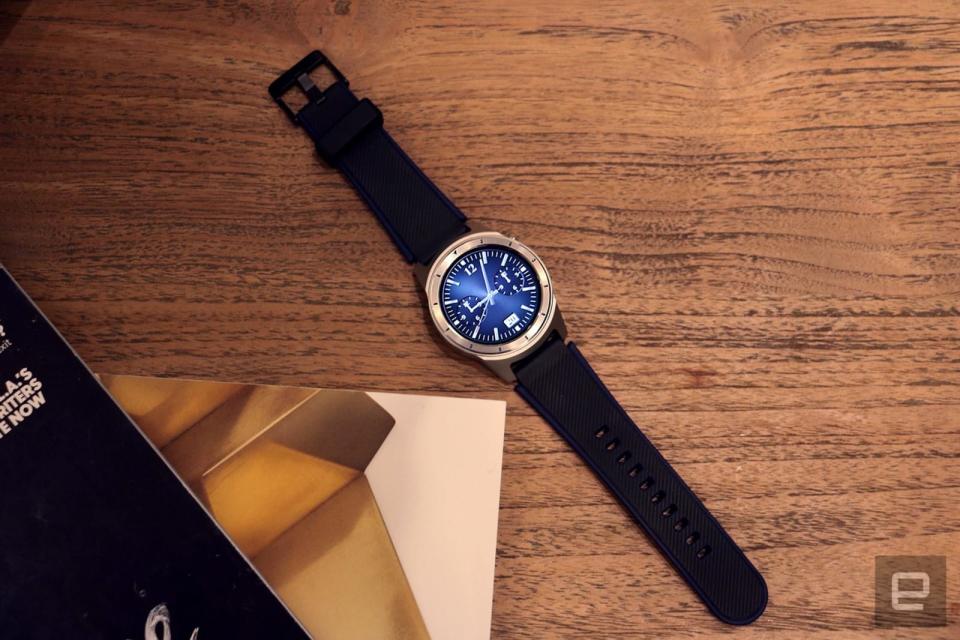The ZTE Quartz is an affordable intro to Android Wear 2.0
Because beginners don’t need advanced features.

ZTE has made a name for itself by selling affordable smartphones that are best described as "not bad." Now, the company is extending its "affordable premium" philosophy to Android Wear watches with the Quartz -- a sub-$200 wearable running Google's newest OS. For $192, the Quartz delivers an onboard radio for phone-free calls and texts, as well as a surprisingly big battery. But despite these features, ZTE isn't going after early adopters. Instead, the Quartz is designed for first-time smartwatch buyers, and, for them, it gets the job done.
Hardware
The Quartz doesn't look cheap, but its design isn't exciting either. Its inoffensive aesthetic can easily be jazzed up, though. You can swap out the default blue-and-black strap for other standard 22mm options. Of course, that adds to the price, but ZTE figures you'd probably want the option of changing the band on pricier smartwatches, too.
What you can't swap, however, is the Quartz's round, 1.4-inch face. The silver case with blue markings in its bezel looks polished, but bland. Like most smartwatches with cellular radios onboard, the Quartz's case is hefty, although it's slightly thinner than the LG Watch Sport. To be fair, though, the Sport houses a few more sensors.
You'll also find the Quartz's AMOLED display adequate for the small words and images you'll be viewing. It has a round, 400 x 400 screen that is bright, sharp and colorful. But it's unfortunately surrounded by an unsightly ring of dead black space.
On the case's edge, at the two o'clock position, is a button you can press to go home or long-press to summon the Google Assistant. The placement is somewhat awkward, since most watches put it at three o'clock, and you'll have to reach ever so slightly further to hit it. That being said, it does prevent accidental presses when my hand bends backwards, which is a problem I encountered with the LG Watch Style, for example, when pushing open doors. Speaking of, I'll be bringing up the Style throughout this review, since its $250 asking price makes it the Quartz's primary competitor.

Unlike the Style, the Quartz's knob is fixed and can't be rotated to scroll through menus and notifications on the screen. It would have been handy, but the omission isn't a deal-breaker, especially at this price.
There are other tradeoffs that you might find more egregious, though. There's no heart rate sensor or NFC here, although the Quartz does have a cellular radio for pulling in data and making calls without a phone. That's something basically every other watch at this price is lacking.
In use
I was concerned that the Quartz's affordability would come with a compromise on performance. But it wasn't significantly slower than more-expensive watches I've tested. The Quartz runs smoothly most of the time, although it occasionally hiccups when launching apps or installing a game via the Play Store. It's also slow to respond to voice commands, whether I'm asking to translate a phrase, write a message or call a friend. But other Android Wear 2.0 devices, like the Tag Heuer Connected Modular 45 and the LG Watch Style, suffer similar delays when dealing with speech.

You're probably not going to play music through the Quartz's onboard speakers very often, but if you do, you'll be happy to know they're loud enough to hear from across a room. This makes hands-free calls possible even in noisy environments. Sound quality is clear enough for voices. But, as you'd expect, music, like the chorus of Nicki Minaj's Starships, sounds distorted and clangy. You can (and should) just connect to a pair of Bluetooth headphones for better quality, though. Thanks to the 4GB of onboard storage, you'll be able to listen to music without lugging your phone around or worrying about cell reception.
What really sets the Quartz apart from the competition, besides its price, is its 500mAh battery. That's larger than what LG and Huawei offer. That's a big deal since Android Wear 2.0 watches tend to conk out before a full 24 hours is up. ZTE is promising 36 hours for the Quartz, and so far that seems pretty accurate, as long as I don't go crazy downloading games or make too many calls. Battery life drops to a day with heavier use, but that's still longer than the LG watches managed.
The competition
Of the handful of watches on the market that come with Android Wear 2.0 already installed, the ZTE Quartz has the lowest price and one of the biggest batteries. Plus, with its cellular support, the Quartz offers more functionality than its closest competitor (in terms of price), the LG Watch Style.
Neither the Style nor the Quartz is attractive, but the LG offering has a rotating dial that makes it faster and easier to scroll through Wear's long lists of notifications and apps. If you detest excessive swiping, consider the Style instead.
To get features like Android Pay and heart rate monitoring, you'll have to spring for the $350 LG Watch Sport or the $300 Huawei Watch 2. Neither of these options is very stylish, though. For a better-looking watch, you might want to wait for one of Fossil Group's 300 upcoming Android Wear models, from brands like Michael Kors, Kate Spade and DKNY.
Still, none of the competition is as affordable as the ZTE Quartz, and its battery life is above average, making it a good option for the budget conscious.
Wrap-up

Ultimately, the ZTE Quartz is an able, basic Android wearable that stands out mostly for its price. Its cellular connectivity is a nice bonus, especially considering the cost, as is its generous battery. The occasional performance issues may put off more-impatient users, but for its target audience of first-time Android Wearers, the Quartz is an affordable way to learn the joys (and pains) of using a smartwatch.












